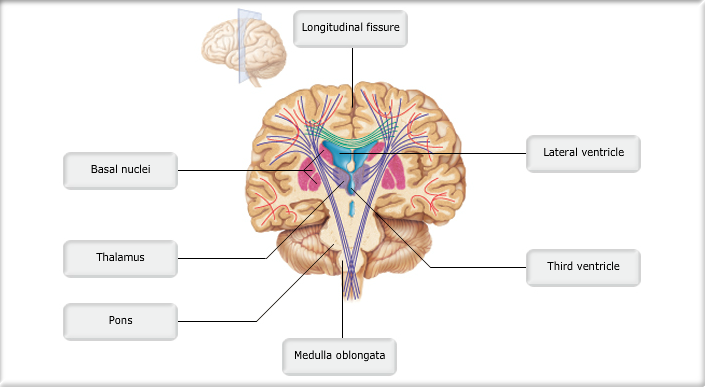
...
Which part of the CNS sorts almost all of the ascending sensory information?
- mesencephalon
- thalamus
- pons
- hypothalamus
- thalamus
- Afferent impulses from all senses and all parts of the body converge on the thalamus and synapse with at least one of its nuclei. The thalamus-- which sorts out and edits these afferent signals before relaying them to the appropriate cortical areas--is considered the gateway to the cerebral cortex. In summary, the thalamus plays a key role in mediating sensation, motor activities, cortical arousal, learning, and memory.
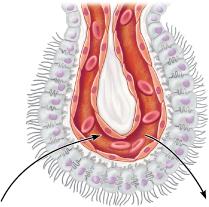
What CNS-associated structure is illustrated in this figure?
- choroid plexus
- hypothalamus
- arachnoid villus
- cerebral aqueduct
- choroid plexus
- Note the specific arrangement of glial cells and capillaries as well as the movements of the fluid.
Which of the following is NOT a function of the hypothalamus?
- regulate body temperature
- regulate emotional responses
- regulate the thalamus
- regulate food intake
- regulate the thalamus
- The hypothalamus does not regulate the thalamus.
Which of the following is NOT a correctly matched pair?
- superficial in the brain: gray matter
- gray matter: myelinated axons
- spinal cord: inner gray matter
- gray matter: location of brain nuclei
- gray matter: myelinated axons
- Gray matter is indicative of unmyelinated axons and cell bodies in the CNS.
Which motor area both has a homunculus and has descending projection fibers?
- premotor cortex
- frontal eye fields
- primary motor cortex
- Broca's area
- primary motor cortex
- The primary motor cortex has projections for the entire human body map, or homunculus. Axons from the primary motor cortex project from the frontal lobe to the spinal cord.
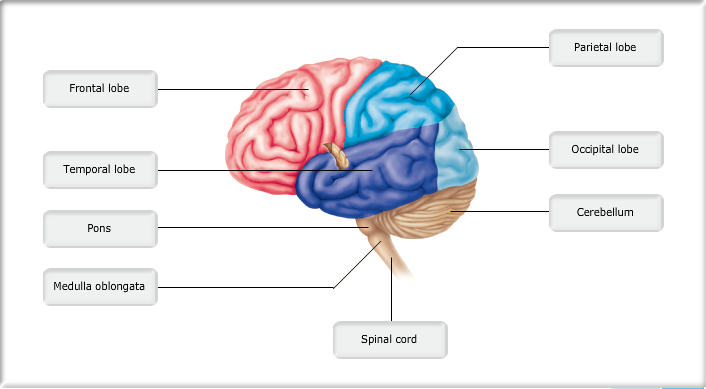
...
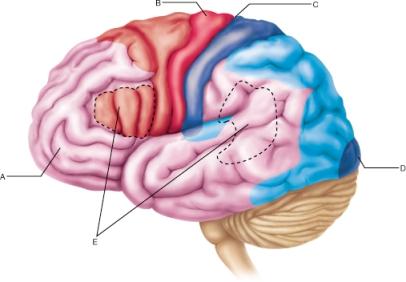
Which of the following is the best description of the function of region B?
- Region B contains neurons receiving somatosensory input from the thalamus.
- Region B coordinates the movement of several muscle groups into complex tasks.
- Region B houses voluntary motor commands.
- Region B includes neurons whose axons carry motor commands from the cerebrum.
- Region B includes neurons whose axons carry motor commands from the cerebrum.
- Region B is the precentral gyrus, the location of the primary (somatic) motor cortex. This is the origin of the descending corticospinal (pyramidal) tracts.
What structure(s) is/are indicated by B?
- pyramidal tracts
- lateral ventricles
- association fibers
- corpus callosum
- corpus callosum
- The corpus callosum is the most prominent example of tracts that connect the left and right cerebral hemispheres.
Which of the meninges is a delicate connective tissue membrane that clings tightly to the brain like cellophane wrap following its every convolution?
- pia mater
- meningeal layer of the dura mater
- arachnoid mater
- periosteal layer of the dura mater
- pia mater
- The pia mater, meaning "gentle mother," is composed of delicate connective tissue and is richly invested with tiny blood vessels. It is the only meninx that clings tightly to the brain, like cellophane wrap, following its every convolution.
In general, a primary sensory cortex breaks down sensory input into component parts, while an association cortex makes sense of sensory inputs.
- True
- False
- True
- The primary sensory cortex receives sensory inputs in their cruder forms, while the association cortex helps you understand what the sensory input means.
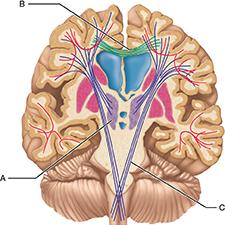
Classify a fiber tract that communicates between the left prefrontal lobe and the left parietal lobe.
- commissural fibers
- association
- projection
- association
- Association fibers communicate between gyri in the same cerebral hemisphere.
Which of the following best describes the hypothalamus?
- gateway to the cerebellum
- visceral control center of the body
- relay station for the special senses
- somatic motor control center
- visceral control center of the body
- The hypothalamus is the main visceral control center of the body and is vitally important to overall body homeostasis. Its chief homeostatic roles include controlling the autonomic nervous system; controlling endocrine system function; regulating the sleep-wake cycle, body temperature, hunger, and thirst; and initiating physical responses to emotions.
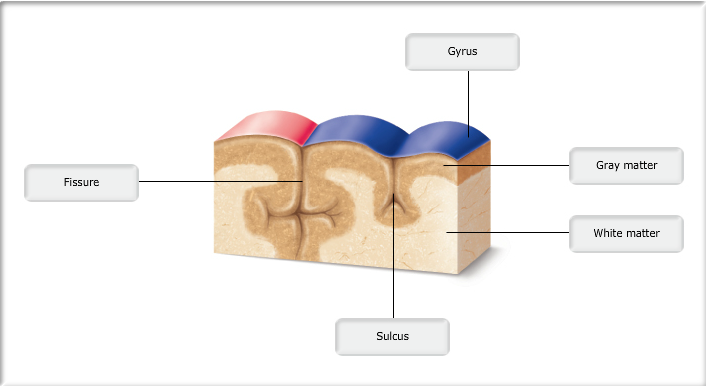
...
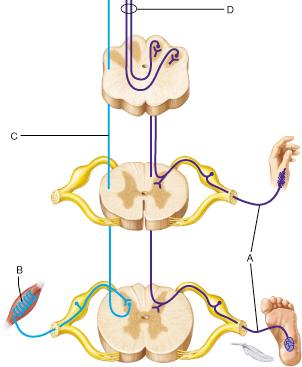
Which of the following describes the nerve fibers indicated by the letter A?
- first-order sensory neurons
- second-order sensory neurons
- third-order sensory neurons
- first-order sensory neurons
- First-order sensory neurons transmit sensory information from receptors to the spinal cord.
Which part of the brain is the "executive suite" that controls almost all brain activity?
- cerebral cortex
- brain stem
- cerebellum
- diencephalon
- cerebral cortex
- The cerebral cortex is the "executive suite" of the nervous system, where most of our higher-level decision making occurs. It enables us to be aware of ourselves and our sensations, communicate, remember, understand, and initiate voluntary movements.
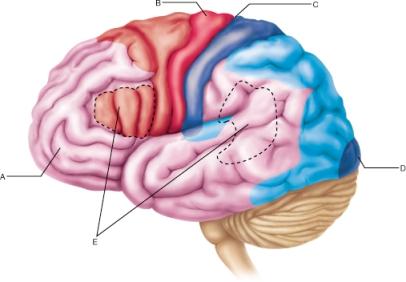
Region A includes which of the following?
- prefrontal cortex
- Broca’s area
- primary motor cortex
- primary somatosensory cortex
- prefrontal cortex
- The prefrontal cortex is located in the anterior region of the frontal lobe.
At age 79, Mrs. X is diagnosed with a disorder that severely impairs her logical judgment. Medical imaging techniques show that this has been most likely caused by brain damage in a ______.
parietal lobe
frontal lobe
temporal lobe
premotor cortex
- frontal lobe
- The frontal lobe has areas that control voluntary motor functions, mood, smell, and social judgment.
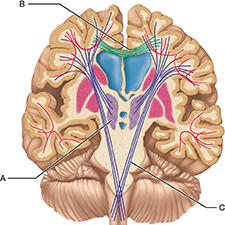
The neural fibers connecting structure A to the cerebral cortex can be described by which of the following?
- third-order sensory neurons
- lower motor neurons
- upper motor neurons
- first-order sensory neurons
- third-order sensory neurons
- Third-order sensory neurons relay ascending information from the thalamus to specific sensory areas of the cortex.
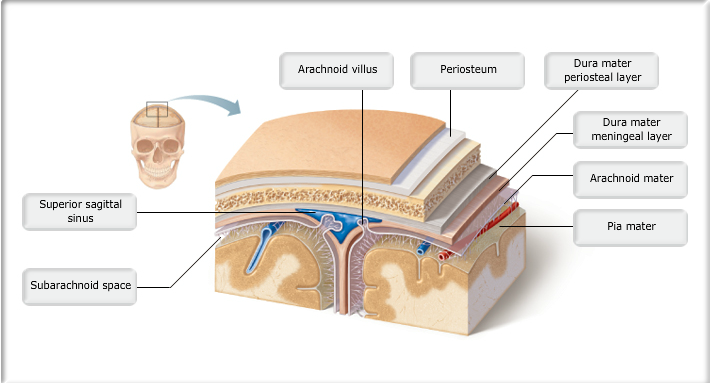
...
Which of the following is true of the cerebral hemispheres of the human brain?
- Nearly the entire surface of the cerebral hemispheres is marked by shallow grooves called gyri.
- The longitudinal fissure separates the cerebral hemispheres from the cerebellum.
- The cerebral hemispheres account for about 83% of total brain mass.
- Nearly the entire surface of the cerebral hemispheres is marked by elevated ridges called sulci.
- The cerebral hemispheres account for about 83% of total brain mass.
- The cerebral hemispheres, which form the superior part of the brain, account for about 83% of total brain mass.
Which of the following statements is correct concerning the spinal cord?
- Spinal nerves have mixed motor and sensory function.
- Just like the cerebrum, the gray matter is found on the superficial surfaces.
- The white matter contains cell bodies for spinal nuclei.
- Damage to sensory tracts in the spinal cord leads to paralysis.
- Spinal nerves have mixed motor and sensory function.
- The ventral roots carry motor commands out of the spinal cord. The dorsal roots carry sensory information into the spinal cord. The spinal nerves represent a fusion of these two elements.
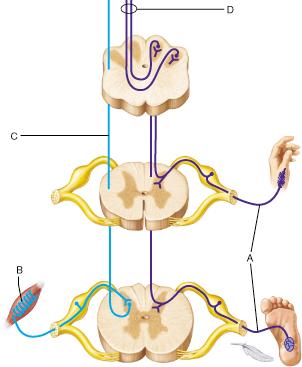
The fiber tracts indicated by the letter D will terminate in the __________.
- primary motor cortex
- primary somatosensory cortex
- thalamus
- cerebral nuclei
- thalamus
- The spinothalamic tracts indicated by D carry somatosensory information and terminate in the thalamus. Specific information will then be relayed to the appropriate area of the somatosensory cortex by third-order sensory neurons.
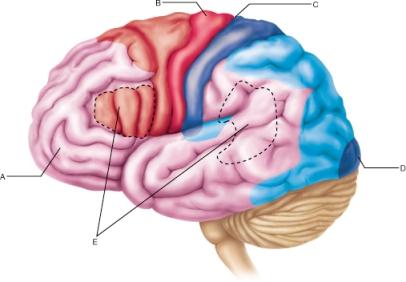
The cortical regions indicated by E are involved in what functions?
- the generation of emotional responses
- They are the control centers for homeostatic and endocrine functions.
- the storage of motor patterns for skilled movements of skeletal muscles
- the production and interpretation of language
- the production and interpretation of language
- Regions indicated by E include Broca's area in the frontal lobe and Wernicke's area in the temporal lobe.
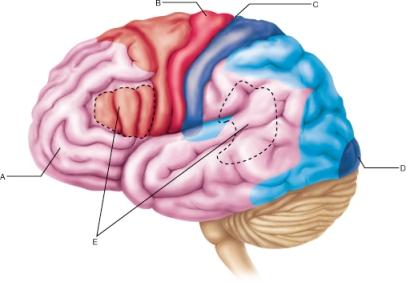
The groove indicated by C is the __________.
- transverse fissure
- lateral sulcus
- longitudinal fissure
- central sulcus
- central sulcus
- The central sulcus is the shallow groove that separates the frontal and parietal lobes.
What part of the spinal cord represents an increase in cell body mass for upper limb control?
- cauda equina
- lumbar enlargement
- conus medullaris
- cervical enlargement
- cervical enlargement
- The spinal cord has an obvious enlargement in the cervical region, called the cervical enlargement, where the cell bodies controlling the upper limbs arise.
Select the true statement regarding first-order neurons.
- First-order neurons descend with motor commands.
- First-order neuron cell bodies reside in a ganglion.
- First-order neurons originate in the CNS.
- First-order neurons usually ascend directly to the thalamus.
- First-order neuron cell bodies reside in a ganglion.
- First-order neurons, whose cell bodies reside in a ganglion (dorsal root or cranial), conduct impulses from the cutaneous receptors of the skin and from proprioceptors to the spinal cord or brain stem, where they synapse with second-order neurons.
__________ is a progressive degenerative disease of the basal nuclei that affects the dopamine-secreting pathways.
- Parkinson's disease
- mad cow disease
- Alzheimer's disease
- Huntington's disease
- Parkinson's disease
- Parkinson's disease results from a degeneration of the dopamine-releasing neurons of the substantia nigra (of the midbrain). As those neurons deteriorate, the dopamine-deprived basal nuclei they target become overactive. Afflicted individuals have a persistent tremor at rest, a forward-bent walking posture and shuffling gait, and a stiff facial expression. They are slow with initiating and executing movement.
Which of the following statements about the cerebellum is NOT correct?
- The cerebellum has a cortex and homunculus, just like the motor cortex.
- The cerebellum plays a role maintaining your balance.
- Damage to the cerebellum could affect posture.
- The cerebellum generates conscious motor commands.
- The cerebellum generates conscious motor commands.
- The cerebellum does not operate at the conscious level of processing.
What characteristic does a spinocerebellar tract neuron share with a sensory neuron originating in the quadriceps femoris?
- Both neurons lack myelin sheathing.
- Both neurons pass through the dorsal root ganglion.
- Both neurons carry afferent information.
- Both neurons interface with gray matter nuclei.
- Both neurons carry afferent information.
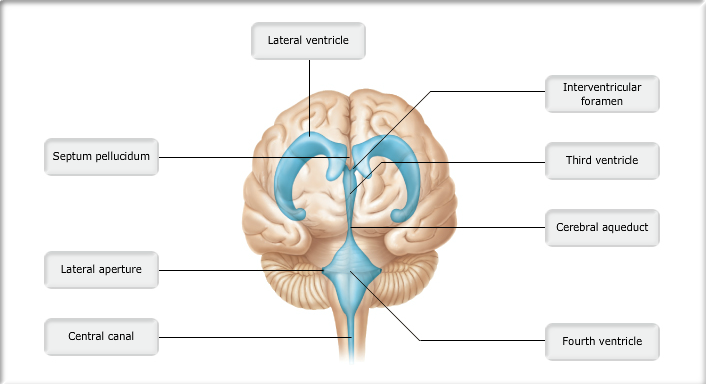
...
The hypothalamus is the area where afferent impulses from all senses and all parts of the body are sorted out and then relayed to the appropriate area of the sensory cortex.
- True
- False
- False
- Afferent impulses from all senses and all parts of the body converge on the thalamus (not the hypothalamus) and synapse with at least one of its nuclei. The thalamus--which sorts out and "edits" these afferent signals before relaying them to the appropriate cortical areas--is considered to be the gateway to the cerebral cortex.
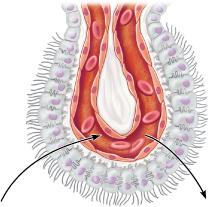
Which type of glial cells are shown in this figure
- microglia
- ependymal cells
- astrocytes
- oligoshendrocytes
- ependymal cells
- Specialized ependymal cells participate in the filtration, absorption, and secretory processes that create cerebrospinal fluid.
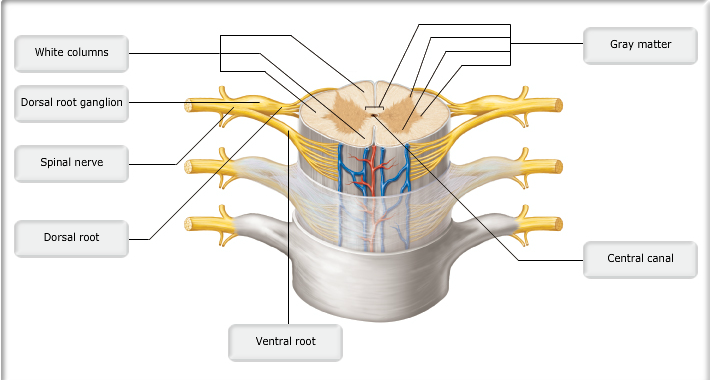
...
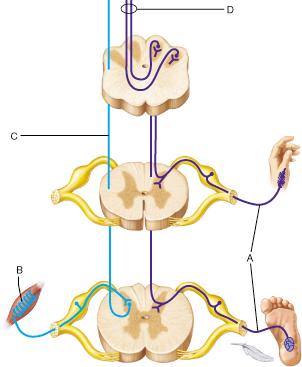
Where are the cell bodies of the sensory neurons at A located?
- in the dorsal root ganglion
- in the medulla oblongata
- in the posterior horn of the spinal cord
- in the thalamus
- in the dorsal root ganglion
- All sensory neurons, including those of the autonomic nervous system, are found in the dorsal root ganglion.